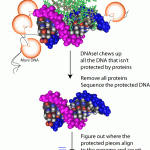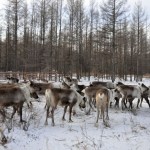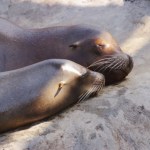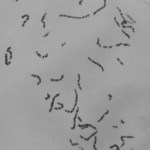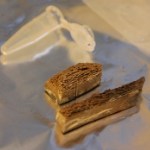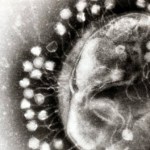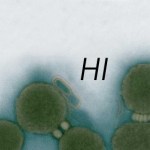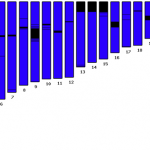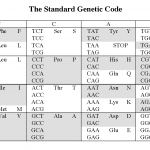Genome
Did you know small fragments of DNA are circulating in your blood stream?
These short pieces of DNA are left behind after cells self-destruct. This self-destruction, or apoptosis, is a normal process. In the case of fetal development, certain cells in our hands die, leaving behind individual fingers. Immune system cells leave traces of DNA behind after they’ve tackled invading microbes. DNA can also appear in the blood when people have cancer.
I had the good fortune, last Monday, to hear Matthew Snyder describe this cell-free DNA in a fascinating talk and learn why DNA in the blood can be a…
Image of Aoluguya reindeer from www.chinatouradvisors.com
Scientists have now determined the complete mitochondrial genome sequence of Aoluguya reindeer (Rangifer tarandus). I wonder if the sequence will hold any more clues as to why Rudolph's nose is so red and bright. Although according to this prior blog entry perhaps it was the other 8 reindeer who were different...
Source:
Ju Y, Liu H, Rong M, Yang Y, Wei H, Shao Y, Chen X, Xing X. Complete mitochondrial genome sequence of Aoluguya reindeer (Rangifer tarandus). Mitochondrial DNA. 3:1-2, 2014. [Epub…
Image of seals from www.fanpop.com/clubs/the-animal-kingdom/images/14060694/title/seal-wall…
Paleogeneticist Dr. Johannes Krause (University of Tübingen, Germany) and colleagues were interested in the origin of tuberculosis (TB) in the Americas. Since strains of TB found in the Americas are related to strains found in Europe, prior theories held that Spaniards may have introduced it to the Americas while colonizing South America. The problem with those theories is that pre-Columbian skeletal remains showed signs of TB much earlier.
Dr. Krause was quoted in Scientific American, “…
Only 1% of the human genome codes for proteins, which might make you wonder what the rest of the nucleotide sequence is good for. In 2012 the Encyclopedia of DNA Elements (or ENCODE) announced that a full 80% of the genome played a biochemical role, interacting with proteins in some way. But a new study says it takes only about 8% of our non-protein-coding genes to make us human. This is the percentage of genes that are 'conserved' by the human species: change one of these genes, and you'll alter the fitness of the individual. These genes evolve slowly (although not as slowly as protein-…
A few weeks back, we published a review about the development and role of the human reference genome. A key point of the reference genome is that it is not a single sequence. Instead it is an assembly of consensus sequences that are designed to deal with variation in the human population and uncertainty in the data. The reference is a map and like a geographical maps evolves though increased understanding over time.
From the Wiley On Line site:
Abstract
Genome maps, like geographical maps, need to be interpreted carefully. Although maps are essential to exploration and navigation they…
Getting an accurate genome sequence requires that you collect the data at least twice argue Robasky, Lewis, and Church in their recent opinion piece in Nat. Rev. Genetics [1].
The DNA sequencing world kicked off 2014 with an audacious start. Andrew Pollack ran an article in the New York Times implying that 100,000 genomes will be the new norm in human genome sequencing projects [2]. The article focused on a collaboration between Regeneron and Geisinger Health in which they plan to sequence the exomes (the ~2% of the genome that encodes proteins and some non-coding RNA) of 100,000…
Image from www.123rf.com
A new study published in the American Journal of Physiology presents data suggesting that birds do not carry a specific anti-inflammatory protein critical for keeping inflammation under control in mammals, reptiles and amphibians.
The specific protein is tristetraprolin (TTP). It functions mainly by inhibiting key mediators of inflammation in the body, such as tumor necrosis factor alpha (TNFa). In fact, mice that are missing this protein have chronic systemic inflammation from unchecked TNFa. Moreover, mice missing the protein specifically in myeloid cells develop…
Bone fragments used for sequencing the ancient horse genome. Image credit: LUDOVIC ORLANDO as published in The Scientist.
Researchers have successfully created a draft sequence of the complete genome of a 700,000 year old horse from a bone fragment extracted from permafrost in the Yukon Territory (Canada). This is the oldest specimen ever sequenced by almost 10-fold. Prior sequencing of the whole genome from a hominid from Siberia who lived 80,000 years ago was the prior record holder.
It is amazing to me that they were able to recover the entire genome from such an old specimen! These…
We were just getting used to the idea of our digestive tract as an ecosystem. There are 10 times as many bacteria in our gut as there are cells in our bodies, and the ecological balance between the different types might affect everything from our tendency to gain weight to our general health and susceptibility to various diseases.
Now, a Weizmann Institute researcher has exposed a whole new layer of this ecosystem: the viruses – called phages – that infect our gut bacteria.
Dr. Rotem Sorek and his team identified hundreds of these phages in the human gut. They were able to find them thanks to…
This week, two press releases from the Institute:
The first was on the sequencing of the woodland strawberry genome (unfortunately, in the same week the cacao genome was sequenced). The Institute scientists who participated in the project contributed in the computational analysis of genes encoding flavor- and aroma-related proteins.
This wild cousin of the cultivated strawberry is a member of the rose family, along with fruit trees including apples, peaches, cherries and almonds. In other words, this small annual plant is sure to become a useful experimental model for plant and agricultural…
What do these three quotations have in common? Hint: it lives in a petri dish.
"To live, to err, to fall, to triumph, and to recreate life out of life." -- James Joyce
"What I cannot build, I cannot understand." -- Richard Feynman
"See things not as they are, but as they might be." -- from American Prometheus, a biography of the nuclear physicist Robert Oppenheimer
Although James Joyce could never have imagined it, his words -- and those of Feynman and Oppenheimer, too -- are no longer relegated to library stacks, but instead live on inside an unlikely host: the world's first synthetic…
Not Exactly Pocket Science is a set of shorter write-ups on new stories with links to more detailed takes by the world's best journalists and bloggers. It is meant to complement the usual fare of detailed pieces that are typical for this blog.
Geneticist sequences own genome, finds genetic cause of his disease
If you've got an inherited disease and you want to find the genetic faults responsible, it certainly helps if you're a prominent geneticist. James Lupski (right) from the Baylor College of Medicine suffers from an incurable condition called Charcot-Marie-Tooth (CMT) disease, which…
Meet !Gubi, the tribal elder of a group of Bushmen (or Khoisan), one of the oldest known human lineages. He lives the life of a hunter-gatherer in the Namibian part of the Kalahari Desert. But he also has a strange connection to James Watson, the British American scientist who helped to discover the structure of DNA. For a start, they're both around 80 years old. But more importantly, they are two of just 11 humans to have their entire genomes sequenced.
Along with Archbishop Desmond Tutu, !Gubi is one of two southern Africans, whose full genomes have been sequenced by Stephan Schuster and…
Meet "Inuk". He is the ninth human to have their entire genome sequenced but unlike the previous eight, he has been dead for some 4,000 years old. Even so, DNA samples from a tuft of his frozen hair have revealed much about his appearance and his ancestry.
Inuk had brown eyes and brown skin. His blood type was A+. His hair was thick and dark but had he lived, he might not have kept it - his genes reveal a high risk of baldness. Inuk may well have died quite young. Like many Asians and Native Americans, his front teeth were "shovel-graded", meaning that their back faces had ridged sides and…
Meet your viral ancestors - how bornaviruses have been infiltrating our genomes for 40 million years
Cast your mind back 40 million years and think about your ancestors. You're probably picturing creatures that looked like a bit like today's monkeys, but they're only part of your family tree. To see your other ancestors, you'd have to whip out an imaginary microscope. Meet your great-great-great-etc-grandviruses.
The human genome is littered with the remains of viruses that, in ages past, integrated their genes into the DNA of our ancestors. They became a permanent fixture, passed down from parent to child. Today, these "endogenous retroviruses", or ERVs, make up around 8% of our genome.…
In a Swiss laboratory, a group of ten robots is competing for food. Prowling around a small arena, the machines are part of an innovative study looking at the evolution of communication, from engineers Sara Mitri and Dario Floreano and evolutionary biologist Laurent Keller.
They programmed robots with the task of finding a "food source" indicated by a light-coloured ring at one end of the arena, which they could "see" at close range with downward-facing sensors. The other end of the arena, labelled with a darker ring was "poisoned". The bots get points based on how much time they spend near…
I notice that Fortune has a story on personal genomics up, Genetic sequencing gets personal Biotech firm Illumina will sequence your entire genetic code -- and throw in a Mac -- for $48,000:
So far, personalized genomics make up just a small fraction of Illumina's revenue. High costs keep sequencing out of reach for most people. But prices will fall substantially as the technology improves. In fact experts say costs could reach $1000 within three to five years, making more people privy to their entire genetic code.
...
One area Illumina is not diving into is sequence analysis. Instead, it is…
There is a reason why there are no dinosaur geneticists - their careers would quickly become as extinct as the 'terrible lizards' themselves. Bones may fossilise, but soft tissues and molecules like DNA do not. Outside of the fictional world of Jurassic Park, dinosaurs have left no genetic traces for eager scientists to study.
Nonetheless, that is exactly what Chris Organ and Scott Edwards from Harvard University have managed to do. And it all started with a simple riddle: which came first, the chicken or the genome?
Like almost all birds, a chicken's genome - its full complement of DNA…
One of the interesting things I learned today was that many people are calling for the genome sequences of the chimps and Macaques to be finished.
This is especially amusing because the human genome isn't quite done. We're primates, too! Why not finish our genome?
[I blame these new-found revelations on Twitter. Despite my youngest daughter's warning that only old people use Twitter, I've joined my SciBlings and taken the plunge. (you can even follow me! @digitalbio).
Now, I get to indulge my geeky tendencies while waiting in line at the grocery store. I just type #cshl and voila! I…
We'll have a blast, I promise! But there's one little thing we need to discuss first...
I want to explain why I'm going to use nucleotide sequences for the blast search. (I used protein the other day). It's not just because someone told me too, there is a solid rational reason for this.
The reason is the redundancy in the genetic code.
Okay, that probably didn't make any sense to those of you who didn't already know the answer. Here it is.
The picture above shows the human genetic code (there are at least 16 variations on this, but that's another story). Each middle cell in the…
